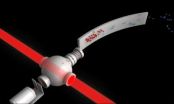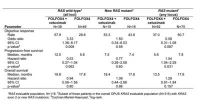(Press-News.org) (Santa Barbara, Calif.) — For his doctoral dissertation in the Goldman Superconductivity Research Group at the University of Minnesota, Yu Chen, now a postdoctoral researcher at UC Santa Barbara, developed a novel way to fabricate superconducting nanocircuitry. However, the extremely small zinc nanowires he designed did some unexpected — and sort of funky — things.
Chen, along with his thesis adviser, Allen M. Goldman, and theoretical physicist Alex Kamenev, both of the University of Minnesota, spent years seeking an explanation for these extremely puzzling effects. Their findings appear this week in Nature Physics.
"We were determined to figure out how we could reconcile the strange phenomena with the longstanding rules governing superconductivity," said lead author Chen. "The coexistence of superconductivity with dissipation, which we observed, is counterintuitive and bends the rules as we know them."
Typically superconductivity and dissipation are thought to be mutually exclusive because dissipation, a process in thermodynamic systems whereby electric energy is transformed into heat, is a feature of a normal — versus a superconductive — state.
"But we discovered that superconductivity and dissipation can coexist under rather generic conditions in what appears to be a universal manner," Chen said.
After long and careful work, which involved both experimental and theoretical efforts, the researchers found an explanation that fits. Behind all of the observed phenomena is a peculiar nonequilibrium state of quasiparticles — electron-like excitations that formed in the nanowires Chen designed.
The quasiparticles are created by phase slips. In a superconductive state, when supercurrent flows through the nanowire, the quantum mechanical function describing the superconductivity of the wire evolves along the length of the wire as a spiral shaped like a child's Slinky toy. From time to time, one of the revolutions of the spiral contracts and disappears altogether. This event is called a phase slip. This quirk generates quasiparticles, giving rise to a previously undiscovered voltage plateau state where dissipation and superconductivity coexist.
"The most significant achievement was making the nanowires smaller and cooler than anyone had done previously," Kamenev said. "This allowed the quasiparticles to travel through the wire faster and avoid relaxation. This leads to a peculiar nonthermal state, which combines properties of a superconductor and a normal metal at the same time."
In addition to discovering this unique phenomenon, the team also found another heretofore-unseen property in the voltage plateau. When a magnetic field is turned on in the voltage plateau state, rather than shrinking the superconducting region, which is what would usually occur, the superconducting area expands and is enhanced.
"This is an unexpected property of very small nanowires," said Goldman.
This state appears to be universal for ultra-small superconducting circuitry like Chen's, which features ideal contacts between the nano-elements and the leads. Such nanoscale superconductors may be key components in future superconducting computer systems.
"Our findings demonstrate that superconducting nanocircuits can be used as a simple, but rather generic platform to investigate nonequilibrium quantum phenomena," Chen concluded.
"Now we need to explore the parameters of nanowires that give rise to the effect and those that don't," Goldman said. "We also need to examine the behavior of wires of different lengths and different materials in order to further define the parameters."
INFORMATION:
Bending the rules
A UCSB postdoctoral scholar in physics discovers a counterintuitive phenomenon: the coexistence of superconductivity with dissipation
2014-06-29
ELSE PRESS RELEASES FROM THIS DATE:
Improved method for isotope enrichment could secure a vital global commodity
2014-06-29
AUSTIN, Texas — Researchers at The University of Texas at Austin have devised a new method for enriching a group of the world's most expensive chemical commodities, stable isotopes, which are vital to medical imaging and nuclear power, as reported this week in the journal Nature Physics. For many isotopes, the new method is cheaper than existing methods. For others, it is more environmentally friendly.
A less expensive, domestic source of stable isotopes could ensure continuation of current applications while opening up opportunities for new medical therapies and fundamental ...
Improved survival with TAS-102 in mets colorectal cancer refractory to standard therapies
2014-06-28
The new combination agent TAS-102 is able to improve overall survival compared to placebo in patients whose metastatic colorectal cancer is refractory to standard therapies, researchers said at the ESMO 16th World Congress on Gastrointestinal Cancer in Barcelona.
"Around 50% of patients with colorectal cancer develop metastases but eventually many of them do not respond to standard therapies," said Takayuki Yoshino of the National Cancer Centre Hospital East in Chiba, Japan, lead author of the phase III RECOURSE trial. "The RECOURSE study shows that TAS-102 improves overall ...
Cetuximab or bevacizumab with combi chemo equivalent in KRAS wild-type MCRC
2014-06-28
For patients with KRAS wild-type untreated colorectal cancer, adding cetuximab or bevacizumab to combination chemotherapy offers equivalent survival, researchers said at the ESMO 16th World Congress on Gastrointestinal Cancer in Barcelona.
"The CALGB/SWOG 80405 trial was designed and formulated in 2005, and the rationale was simple: we had new drugs --bevacizumab and cetuximab-- and the study was designed to determine if one was better than the other in first-line for patients with colon cancer," said lead study author Alan P. Venook, distinguished Professor of Medical ...
Herpes virus infection drives HIV infection among non-injecting drug users in New York
2014-06-27
HIV and its transmission has long been associated with injecting drug use, where hypodermic syringes are used to administer illicit drugs. Now, a newly reported study by researchers affiliated with New York University's Center for Drug Use and HIV Research (CDUHR) in the journal PLOS ONE, shows that HIV infection among heterosexual non-injecting drug users (no hypodermic syringe is used; drugs are taken orally or nasally) in New York City (NYC) has now surpassed HIV infection among persons who inject drugs.
The study, "HSV-2 Co-Infection as a Driver of HIV Transmission ...
Potential Alzheimer's drug prevents abnormal blood clots in the brain
2014-06-27
Without a steady supply of blood, neurons can't work. That's why one of the culprits behind Alzheimer's disease is believed to be the persistent blood clots that often form in the brains of Alzheimer's patients, contributing to the condition's hallmark memory loss, confusion and cognitive decline.
New experiments in Sidney Strickland's Laboratory of Neurobiology and Genetics at Rockefeller University have identified a compound that might halt the progression of Alzheimer's by interfering with the role amyloid-β, a small protein that forms plaques in Alzheimer's brains, ...
'Bad' video game behavior increases players' moral sensitivity
2014-06-27
BUFFALO, N.Y. — New evidence suggests heinous behavior played out in a virtual environment can lead to players' increased sensitivity toward the moral codes they violated.
That is the surprising finding of a study led by Matthew Grizzard, PhD, assistant professor in the University at Buffalo Department of Communication, and co-authored by researchers at Michigan State University and the University of Texas, Austin.
"Rather than leading players to become less moral," Grizzard says, "this research suggests that violent video-game play may actually lead to increased moral ...
Ancient ocean currents may have changed pace and intensity of ice ages
2014-06-27
Climate scientists have long tried to explain why ice-age cycles became longer and more intense some 900,000 years ago, switching from 41,000-year cycles to 100,000-year cycles.
In a paper published this week in the journal Science, researchers report that the deep ocean currents that move heat around the globe stalled or may have stopped at that time, possibly due to expanding ice cover in the Northern Hemisphere.
"The research is a breakthrough in understanding a major change in the rhythm of Earth's climate, and shows that the ocean played a central role," says ...
Research gives unprecedented 3-D view of important brain receptor
2014-06-27
PORTLAND, Ore. — Researchers with Oregon Health & Science University's Vollum Institute have given science a new and unprecedented 3-D view of one of the most important receptors in the brain — a receptor that allows us to learn and remember, and whose dysfunction is involved in a wide range of neurological diseases and conditions, including Alzheimer's, Parkinson's, schizophrenia and depression.
The unprecedented view provided by the OHSU research, published online June 22 in the journal Nature, gives scientists new insight into how the receptor — called the NMDA receptor ...
Study: To address climate change, nothing substitutes for reducing CO2 emissions
2014-06-27
The politically expedient way to mitigate climate change is essentially no way at all, according to a comprehensive new study by University of Chicago climatologist Raymond Pierrehumbert.
Among the climate pollutants humans put into the atmosphere in significant quantities, the effects of carbon dioxide (CO2) are the longest-lived, with effects on climate that extend thousands of years after emissions cease. But finding the political consensus to act on reducing CO2 emissions has been nearly impossible. So there has been a movement to make up for that inaction by reducing ...
Some aggressive cancers may respond to anti-inflammatory drugs
2014-06-27
New research raises the prospect that some cancer patients with aggressive tumors may benefit from a class of anti-inflammatory drugs used to treat rheumatoid arthritis.
Studying triple-negative breast cancer, researchers at Washington University School of Medicine in St. Louis found that some aggressive tumors rely on an antiviral pathway that appears to drive inflammation, widely recognized for roles in cancer, rheumatoid arthritis and other inflammatory diseases.
The tumors that activate this particular antiviral pathway always have dysfunctional forms of the proteins ...
LAST 30 PRESS RELEASES:
School meals could unlock major gains for human and planetary health
Menopause hormone therapy does not appear to impact dementia risk
Signature patterns of brain activity may help predict recovery from traumatic brain injury
Dresden study uncovers new key mechanism in cancer cells
New species are now being discovered faster than ever before, study suggests
Cannabis-based products show limited short-term benefit for chronic pain, with increased risk of adverse effects
Cannabis products with more THC slightly reduce pain but cause more side effects
Clearing the brain of aging cells could aid epilepsy and reduce seizures
Brain injuries linked with potential risk of suicide, new study finds
New technique lights up where drugs go in the body, cell by cell
New study finds movement of fishing fleets can reveal shifts in marine ecosystems
Embargoed: New evidence points to potential treatment for vascular dementia
Study uncovers disrupted brain balance in alcohol dependence
Working in groups can help Republicans and Democrats agree on controversial content moderation online
Structural findings reveal how distinct GPCR ligands create different levels of activation
Anything-goes “anyons” may be at the root of surprising quantum experiments
UC review: Maximizing workplace opportunity for veterans
From generation to complex control: Metasurfaces make perfect vortex beams "within reach"
Thin-film lithium niobate-based detector: recent advances and perspectives
Exploring why some people may tend to persistently make bad choices
How cells balance their protein levels
Nirsevimab vs RSVpreF vaccine for RSV–related hospitalization in newborns
Effectiveness and impact of maternal RSV immunization and nirsevimab on medically attended RSV in US children
AI gives scientists a boost, but at the cost of too many mediocre papers
Next-generation vision model maps tree growth at sub-meter precision
Genes aren’t destiny for inherited blindness, study shows
MIT study: High-fat diets make liver cells more likely to become cancerous
Exposure to multiple fine particulate matter components and incident depression in the US Medicare population
Risk of burdensome health care spending over time in the US
Nirsevimab against hospitalizations and emergency department visits for lower respiratory tract infection in infants
[Press-News.org] Bending the rulesA UCSB postdoctoral scholar in physics discovers a counterintuitive phenomenon: the coexistence of superconductivity with dissipation






